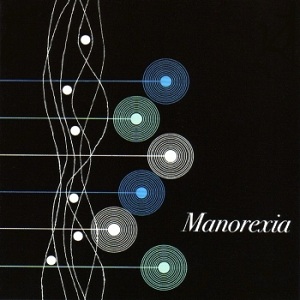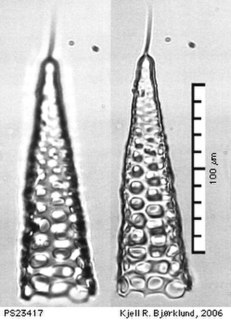Related Research Articles

Zooplankton are heterotrophic plankton. Plankton are organisms drifting in oceans, seas, and bodies of fresh water. The word zooplankton is derived from the Greek zoon (ζῴον), meaning "animal", and planktos (πλαγκτός), meaning "wanderer" or "drifter". Individual zooplankton are usually microscopic, but some are larger and visible to the naked eye.

Chert is a hard, fine-grained sedimentary rock composed of microcrystalline or cryptocrystalline quartz, the mineral form of silicon dioxide (SiO2). Chert is characteristically of biological origin, but may also occur inorganically as a chemical precipitate or a diagenetic replacement, as in petrified wood.

The Radiolaria, also called Radiozoa, are protozoa of diameter 0.1–0.2 mm that produce intricate mineral skeletons, typically with a central capsule dividing the cell into the inner and outer portions of endoplasm and ectoplasm. The elaborate mineral skeleton is usually made of silica. They are found as zooplankton throughout the global ocean. As zooplankton, radiolarians are primarily heterotrophic, but many have photosynthetic endosymbionts and are, therefore, considered mixotrophs. The skeletal remains of some types of radiolarians make up a large part of the cover of the ocean floor as siliceous ooze. Due to their rapid change as species and intricate skeletons, radiolarians represent an important diagnostic fossil found from the Cambrian onwards.

The polycystines are a group of radiolarians. They include the vast majority of the fossil radiolaria, as their skeletons are abundant in marine sediments, making them one of the most common groups of microfossils. These skeletons are composed of opaline silica. In some it takes the form of relatively simple spicules, but in others it forms more elaborate lattices, such as concentric spheres with radial spines or sequences of conical chambers.

Medeski Martin & Wood is an American avant-jazz-funk band formed in 1991, consisting of John Medeski on keyboards, Billy Martin on drums, and Chris Wood on bass. The band is influenced by musical traditions including funk and hip hop and is known for an unconventional style sometimes described as "avant-groove".

Anthony John Medeski is an American jazz keyboard player and composer. Medeski is a veteran of New York's 1990s avant-garde jazz scene and is known popularly as a member of Medeski Martin & Wood. He plays the acoustic piano and an eclectic array of keyboards, including the Hammond B3 organ, melodica, mellotron, clavinet, ARP String Ensemble, Wurlitzer electric piano, Moog Voyager Synthesizer, Wurlitzer 7300 Combo Organ, Vox Continental Baroque organ, and Yamaha CS-1 Synthesizer, among others. When playing acoustic piano, Medeski usually plays the Steinway piano and is listed as a Steinway Artist.

Billy Martin is an American jazz drummer, best known as a member of jazz-funk trio Medeski Martin & Wood.
The Syndiniales are an order of early branching dinoflagellates, found as parasites of crustaceans, fish, algae, cnidarians, and protists. The trophic form is often multinucleate, and ultimately divides to form motile spores, which have two flagella in typical dinoflagellate arrangement. They lack a theca and chloroplasts, and unlike all other orders, the nucleus is never a dinokaryon. A well-studied example is Amoebophrya, which is a parasite of other dinoflagellates and may play a part in ending red tides. Several MALV groups have been assigned to Syndiniales; recent studies, however, show paraphyly of MALVs suggesting that only those groups that branch as sister to dinokaryotes belong to Syndiniales.

Radiolarite is a siliceous, comparatively hard, fine-grained, chert-like, and homogeneous sedimentary rock that is composed predominantly of the microscopic remains of radiolarians. This term is also used for indurated radiolarian oozes and sometimes as a synonym of radiolarian earth. However, radiolarian earth is typically regarded by Earth scientists to be the unconsolidated equivalent of a radiolarite. A radiolarian chert is well-bedded, microcrystalline radiolarite that has a well-developed siliceous cement or groundmass.

Howard Fox was a shipping agent and played a large part in the economic and cultural development of the town of Falmouth, Cornwall. He was a member of the influential Fox family of Falmouth.

Siliceous ooze is a type of biogenic pelagic sediment located on the deep ocean floor. Siliceous oozes are the least common of the deep sea sediments, and make up approximately 15% of the ocean floor. Oozes are defined as sediments which contain at least 30% skeletal remains of pelagic microorganisms. Siliceous oozes are largely composed of the silica based skeletons of microscopic marine organisms such as diatoms and radiolarians. Other components of siliceous oozes near continental margins may include terrestrially derived silica particles and sponge spicules. Siliceous oozes are composed of skeletons made from opal silica Si(O2), as opposed to calcareous oozes, which are made from skeletons of calcium carbonate organisms (i.e. coccolithophores). Silica (Si) is a bioessential element and is efficiently recycled in the marine environment through the silica cycle. Distance from land masses, water depth and ocean fertility are all factors that affect the opal silica content in seawater and the presence of siliceous oozes.
Hemipelagic sediment, or hemipelagite, is a type of marine sediment that consists of clay and silt-sized grains that are terrigenous and some biogenic material derived from the landmass nearest the deposits or from organisms living in the water. Hemipelagic sediments are deposited on continental shelves and continental rises, and differ from pelagic sediment compositionally. Pelagic sediment is composed of primarily biogenic material from organisms living in the water column or on the seafloor and contains little to no terrigenous material. Terrigenous material includes minerals from the lithosphere like feldspar or quartz. Volcanism on land, wind blown sediments as well as particulates discharged from rivers can contribute to Hemipelagic deposits. These deposits can be used to qualify climatic changes and identify changes in sediment provenances.

The Radiolarian Ooze is the second album from Manorexia, it was released in 2002 by Ectopic Ents. Like its predecessor, Volvox Turbo, The Radiolarian Ooze is self-distributed by J. G. Thirlwell and sold exclusively at the Official Foetus Website.
Tholoniidae is a family of radiolarians in the order Spumellaria.
Tritrabidae is a family of radiolarians in the order Spumellaria. They range in age from 235 to 125 million years.
The genus Stylodictya belongs to a group of organisms called the Radiolaria. Radiolarians are amoeboid protists found as zooplankton in oceans around the world and are typically identified by their ornate skeletons.

Cornutella profunda is a species of radiolarian in the family Theoperidae and the genus Cornutella. The abundance and actual geographic span of C. profunda has not yet been fully explored, however few have been caught in various regions around the world. Samples have seen in larger numbers in the Adriatic Sea, the South China Sea, and far off the coast of Southern Africa near Namibia, and in smaller numbers in all other oceans around the world.

Collosphaera is a radiolarian genus in the family Collosphaeridae. The genus contains bioluminescent species. It is a genus of colonial radiolarians.

Many protists have protective shells or tests, usually made from silica (glass) or calcium carbonate (chalk). Protists are mostly single-celled and microscopic. Their shells are often tough mineralised forms that resist degradation, and can survive the death of the protist as a microfossil. Although protists are very small, they are ubiquitous. Their numbers are such that their shells play a huge part in the formation of ocean sediments, and in the global cycling of elements and nutrients.
References
- ↑ De Wever, Patrick; Dumitrica, Paulian; Caulet, J.P.; Nigrini, Catherine & Caridroit, M. (28 February 2002). Radiolarians in the Sedimentary Record (1st ed.). Amsterdam: CRC Press (published 2002). p. 401. ISBN 9789056993368. OL 9106650M . Retrieved July 26, 2015.